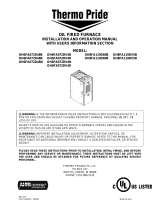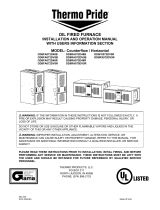Page is loading ...

20. MAINTENANCE AND SERVICE
Routine Maintenance By Home Owner
Other than remembering to arrange for the annual
professional servicing of the furnace by the service or
installation contractor, the most important routine service
performed by the homeowner is to maintain the air filter
or filters. A dirty filter can cause the furnace to over-heat,
fail to maintain indoor temperature during cold weather,
increase fuel consumption and cause component failure.
The furnace filter(s) should be inspected, cleaned or
replaced monthly. The furnace is factory equipped with a
semi-permanent type filter. If the filter is damaged,
replace with filters of the same size and type. (See
Appendix A, Table A-8).
During the routine service, inspect the general condition
of the furnace watching for signs of oil leaks in the vicinity
of the oil burner, soot forming on any external part of the
furnace, soot forming around the joints in the vent pipe,
etc. If any of these conditions are present, please advise
your service or installation contractor.
Annual Service By Contractor
THE COMBUSTION CHAMBER (FIREPOT) IS
FRAGILE. USE CARE WHEN INSPECTING AND
CLEANING THIS AREA.
The heat exchanger should be inspected periodically and
cleaned if necessary. If cleaning is necessary, SHUT
OFF POWER TO THE FURNACE and remove the
burner. Using a stiff brush with a wire handle, brush off
scale and soot from inside the drum and flue pipe. To
clean the radiator, remove the clean-out caps screws,
and remove the caps carefully to avoid tearing the
gaskets. A wire brush can be used to loosen dirt and
debris on the inside surfaces of the radiator. Clean out all
accumulated dirt, soot and debris with a wire handled
brush and an industrial vacuum cleaner. Before replacing
the clean-out caps, inspect the gaskets. If the gaskets
are broken, remove the remnants and replace with new
gaskets.
The blower motor is factory oiled and permanently
sealed. DO NOT LUBRICATE. Excess oil causes
premature electric motor failure.
Inspect the blower fan. Clean if necessary.
Oil Burner Maintenance: Follow the instructions of the oil
burner manufacturer. (See oil burner manufacturer's
instructions supplied with furnace or burner). It is
advisable to change the oil burner nozzle and oil filter on
an annual basis.
The venting system should be cleaned and inspected for
signs of deterioration. Replace pitted or perforated vent
pipe and fittings. The barometric damper should
open and close freely.
All electrical connections should be checked to
ensure tight connections. Safety controls such as
the high limit controls should be tested for
functionality. The fan control should be checked to
ensure that the fan on and off delay function
continues to start and stop the blower fan at the
optimal settings.
21. OPERATING INSTRUCTIONS (HML-C)
Before Lighting
Open all supply and return air registers and grilles.
Open all valves in oil pipes.
Turn on electric power supply
To Light Unit
Set the thermostat above room temperature to call
for heat. The burner should start. NOTE: It may be
necessary to press the RESET button on the
primary combustion control relay.
There will be a fan on time delay before the
circulating fan is energized. The United
Technologies 1158-120 has an adjustable fan on
time that is set by selecting the dipswitch
combination displayed in Chart 1. This fan on delay
can be set at 1, 2, 4 or 6 minutes.
Set the thermostat below room temperature. The oil
burner should stop.
The air circulation blower will continue to run until
the time off setting selected on the electronic fan
timer control times out. The United Technologies
1158-120 has an adjustable fan off time of 30, 60,
90 or 120 seconds. The fan timer control
adjustments may be altered if the air at the room
registers is uncomfortably high upon blower start up
or shutdown.
The necessary adjustments to the fan control
settings should be determined by measuring the
temperature of the air in the supply air take-off, or
within the first few inches of the supply air trunk. The
side mid point of the transition is usually ideal,
providing that the thermometer probe is beyond the
"line of sight" wherein false readings from radiant
heat could be observed. System temperature rise is
the difference in temperature between the supply air
and return air.
To check the operation of the limit switch, shut off
power to the furnace. Temporarily remove the
neutral wire from the direct drive blower motor.
Restore the electrical power to the furnace and set
the thermostat above room temperature.
30173 Rev B 4/29/2008
8

After three or four minutes of burner operation, the limit
control should turn the burner off. When the limit function
test is complete, shut off electrical power to the furnace,
replace the neutral wire to the blower fan motor, and then
restore power. The blower fan will start up immediately.
Once the temperature has dropped and the limit control
has reset, the fan will operate until the fan off time is
achieved. The oil burner will then resume operation and
continue until the thermostat is satisfied. Restore the
thermostat setting to a comfortable temperature.
30173 Rev B 4/29/2008
9
To Shut Down Unit
Set the thermostat to the lowest possible setting.
Set the manual switch (if installed) in the Electrical Power
Supply Line to "OFF".
21. OPERATING INSTRUCTIONS (HMLV-C)
Before Lighting
Open all supply and return air registers and grilles.
Open all valves in oil pipes.
Turn on electric power supply
To Light Unit
Set the thermostat above room temperature to call for
heat. The burner should start. NOTE: It may be
necessary to press the RESET button on the primary
combustion control relay.
There will be a fan on time delay before the circulating
fan is energized. The United Technologies 1168-1 has
an adjustable fan on/off time delay that is programmed
into the ECM motor, and is set by selecting the SW4 DIP
switch combination displayed in Table A-10 page 15.
Fan on/off delay must be adjusted according to input
(nozzle size).
1. Set the thermostat below room temperature. The oil
burner should stop.
The air circulation blower will continue to run until the
blower off delay setting programmed into the ECM motor
times out.
To check the operation of the limit switch, shut off power
to the furnace. Temporarily remove the 5 pin power
connector plug from the ECM blower motor. NOTE:
Isolate the AC Line pins on the 5 pin power
connector with electrical tape to prevent electric
shock hazard. Restore the electrical power to the
furnace and set the thermostat above room temperature.
After three or four minutes of burner operation, the limit
control should turn the burner off. When the limit function
test is complete, shut off electrical power to the furnace,
replace the 5 pin power plug to the blower fan motor, and
then restore power. The blower fan will start up
immediately. Once the temperature has dropped and the
limit control has reset, the fan will operate until the fan off
time is achieved. The oil burner will then resume
operation and continue until the thermostat is
satisfied. Restore the thermostat setting to a
comfortable temperature.
NOTE: IF THE FURNACE IS TO BE SHUT
DOWN FOR AN EXTENDED PERIOD OF
TIME, CLOSE THE OIL SUPPLY VALVE TO
THE BURNER.
DO NOT ATTEMPT TO START THE BURNER
WHEN EXCESS OIL HAS ACCUMULATED,
WHEN THE FURNACE IS FULL OF VAPOUR,
OR WHEN THE COMBUSTION CHAMBER IS
VERY HOT. NEVER BURN GARBAGE OR
PAPER IN THE FURNACE, AND NEVER
LEAVE PAPER OR RAGS AROUND THE
UNIT.
22. ECM BLOWER MOTOR OPERATION
(HMLV-C)
Setting Blower “ON” and “OFF” Timings
Blower on/off time delays are handled by ECM
motor programming. Features of this ECM variable
speed motor are that it will deliver a constant airflow
within a wide range of external static pressures, and
also includes:
Soft Start: This ECM variable speed motor will
slowly ramp up to the required operating speed.
This feature in the heating cycle allows the heat
exchanger to reach operating temperature before
the set heat speed, which minimizes noise and
increases comfort.
Soft Stop: At the end of the heating cycle, the ECM
variable speed motor will slowly ramp down. This
feature allows for increased energy efficiency and
reduced noise levels.
Dehumidification: A dehumidification feature has
been programmed into the variable speed motor. At
the start of each cooling cycle, the variable speed
motor will run at 82% of the rated airflow for 7.5
minutes. After 7.5 minutes has elapsed, the motor
will increase to 100% of the rated airflow. This
profile is used to provide dehumidification and
improve system efficiency.
Continuous Fan Operation: When the thermostat
continuous fan (G) switch is on without a call for
heating or cooling, the indoor fan is immediately
energized up to 50% of the cooling speed. This
feature allows continuous circulation of air between
calls for heating or cooling.
If a call for heat (W) or cool (Y) occurs during
continuous fan, the blower will remain energized
/



